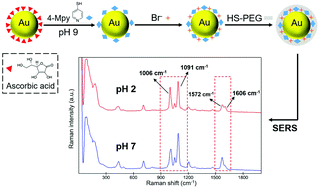Bromide ion-functionalized nanoprobes for sensitive and reliable pH measurement by surface-enhanced Raman spectroscopy†
Abstract
4-Mercaptopyridine (4-Mpy) is a pH reporter molecule commonly used to functionalize nanoprobes for surface-enhanced Raman spectroscopy (SERS) based pH measurements. However, nanoprobes functionalized by 4-Mpy alone have low pH sensitivity and are subject to interference by halide ions in sample media. To improve nanoprobe pH sensitivity and reliability, we functionalized gold nanoparticles (AuNPs) with both 4-Mpy and bromide ion (Br−). Br− electrostatically stabilizes protonated 4-Mpy, thus enabling sensitive SERS detection of the protonation state of 4-Mpy as a function of pH while also reducing variability caused by external halide ions. Through optimization of the functionalization parameters, including suspension pH, [4-Mpy], and [Br−], the developed nanoprobes enable monitoring of pH from 2.1 to 10 with high SERS activity and minimal interference from halide ions within the sample matrix. As a proof of concept, we were able to track nanoprobe location and image the pH distribution inside individual cancer cells. This study provides a novel way to engineer reliable 4-Mpy-functionalized SERS nanoprobes for the sensitive analysis of spatially localized pH features in halide ion-containing microenvironments.



 Please wait while we load your content...
Please wait while we load your content...